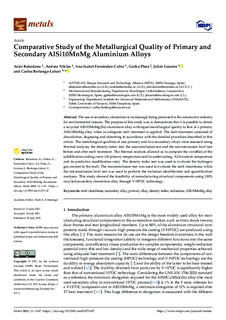Izenburua
Comparative Study of the Metallurgical Quality of Primary and Secondary AlSi10MnMg Aluminium AlloysEgilea (beste erakunde batekoa)
Bertsioa
Bertsio argitaratua
Eskubideak
© 2021 by the authors. Licensee MDPISarbidea
Sarbide irekiaArgitaratzailearen bertsioa
https://doi.org/10.3390/met11071147Non argitaratua
Metals Vol. 11. N. 7. N. artículo 1147,Argitaratzailea
MDPIGako-hitzak
melt cleanliness
secondary alloy
primary alloy
density index ... [+]
secondary alloy
primary alloy
density index ... [+]
melt cleanliness
secondary alloy
primary alloy
density index
inclusions
AlSi10MnMg alloy
Aluminum alloys [-]
secondary alloy
primary alloy
density index
inclusions
AlSi10MnMg alloy
Aluminum alloys [-]
Laburpena
The use of secondary aluminium is increasingly being promoted in the automotive industry for environmental reasons. The purpose of this study was to demonstrate that it is possible to obtain a recycle ... [+]
The use of secondary aluminium is increasingly being promoted in the automotive industry for environmental reasons. The purpose of this study was to demonstrate that it is possible to obtain a recycled AlSi10MnMg(Fe) aluminium alloy with equal metallurgical quality to that of a primary AlSi10MnMg alloy when an adequate melt treatment is applied. The melt treatment consisted of deoxidation, degassing and skimming in accordance with the detailed procedure described in this article. The metallurgical qualities of one primary and two secondary alloys were assessed using thermal analysis, the density index test, the macroinclusion test and the microinclusion level test before and after melt treatment. The thermal analysis allowed us to compare the variables of the solidification cooling curve (Al primary temperature and its undercooling; Al-Si eutectic temperature and its predictive modification rate). The density index test was used to evaluate the hydrogen gas content in the melt. The macroinclusion test was used to evaluate the melt cleanliness, while the microinclusion level test was used to perform the inclusion identification and quantification analyses. This study showed the feasibility of manufacturing structural components using 100% recycled secondary aluminium alloy through V-HPDC technology. [-]
Sponsorship
Gobierno VascoProjectu ID
GV/Elkartek 2019/KK-2019-00080/CAPV/Procesos y materiales innovadores para aplicaciones estructurales de aluminio en el sector automotriz/INNPROALBildumak
Item honek honako baimen-fitxategi hauek dauzka asoziatuta:
Bestelakorik adierazi ezean, itemaren baimena horrela deskribatzen da: Attribution 4.0 International
Related items
Showing items related by title, author, creator and subject.
-
Corrosion and tribocorrosion characterisation of Ti13Nb13Zr alloy in oral environment for dental implants
Golvano Escobal, Ione (Mondragon Unibertsitatea. Goi Eskola Politeknikoa, 2015)Ageing of the population together with the increase of life’s quality in developed societies, has lead to a change of population needs from the health point of view. Dentist placing dentures are increasingly fewer, since ... -
Neural Network Direct Control with Online Learning for Shape Memory Alloy Manipulators
Loidi Eguren, Ion (MDPI AG, 2019)New actuators and materials are constantly incorporated into industrial processes, and additional challenges are posed by their complex behavior. Nonlinear hysteresis is commonly found in shape memory alloys, and the ... -
Influence of Surface Finish and Porosity on the Fatigue behaviour of A356 Aluminium Casting Alloy
Hidalgo, Raquel; Esnaola, Jon Ander; Llavori, Inigo; Larrañaga, Miren; Herrero-Dorca, Nuria; Hurtado, Iñaki; Kortabarria, Aitor (EDP Sciences, 2018)In casting parts, due to the manufacturing process, the presence of defects such as porosity, inclusions and oxide films is unavoidable. All these irregularities have a negative effect on the component ...






















